|
|
Post by Bonobo on Apr 14, 2010 15:41:04 GMT 1
It is time to make a thread about Katyn which is a general term for Soviet war crimes on Polish POWs in a few places in the Soviet Union.
In short: in August 1939 Hitler`s Germany and Stalin`s Soviet Union signed a pact in which they shared the spheres of influence in Eastern Europe. One of their plans was the invasion and partition of Poland.
Nazi Germans started the war on 1 September 1939 and on 17th they were joined by the Red Army in the East.
The Red Army captured about 500.000 Polish soldiers. The officer corps was seperated and put in 3 camps under Stalin`s secret police`s, NKVD, supervision. Interrogations started, whose conclusion was crushing - 15.000 officers, most of them civilians drafted to the army for 1939 war, were declared as confirmed enemies of the Soviet Union, Stalin and communism.
After such a declaration stalinist communism applied its typical measure - execution. Killing started in April 1940. Only about 300 survived.
Altogether, about 22.000 men from the officer corps as well as representatives of Polish intelligentsia and leading classes were annihilated by Soviet communists solely in 1940. The most famous execution and burial site is Katyn, but there were a few others, too.
|
|
|
|
Post by Bonobo on Apr 14, 2010 16:09:47 GMT 1
en.wikipedia.org/wiki/Katyn_massacre
The Katyn massacre, also known as the Katyn Forest massacre (Polish: zbrodnia katyńska, 'Katyń crime'; Russian: Катынский расстрел), was a mass murder of Polish nationals imprisoned by the Soviet NKVD, based on a proposal from Lavrentiy Beria to execute all members of the Polish Officer Corps. Dated 5 March 1940, this official document was then approved (signed) by the entire Soviet Politburo including Joseph Stalin and Beria.[1][2][3] The number of victims is estimated at about 22,000, the most commonly cited number being 21,768.[4] The victims were murdered in the Katyn Forest in Russia, the Kalinin and Kharkov prisons and elsewhere.[5] About 8,000 were officers taken prisoner during the 1939 Soviet invasion of Poland, the rest being Polish doctors, professors, lawmakers, police officers, and other public servants arrested for allegedly being "intelligence agents, gendarmes, saboteurs, landowners, factory owners, lawyers, priests, and officials."[4] Since Poland's conscription system required every unexempted university graduate to become a reserve officer,[6] the NKVD was able to round up much of the Polish intelligentsia, and the Russian, Ukrainian, Protestant, Muslim Tatar, Jewish, Georgian,[7] and Belarusian intelligentsia of Polish citizenship.[8]
The term "Katyn massacre" originally referred specifically to the massacre at Katyn Forest, near the villages of Katyn and Gnezdovo (ca. 19 kilometres (12 mi) west of Smolensk, Russia), of Polish military officers in the Kozelsk prisoner-of-war camp. This was the largest of the simultaneous executions of prisoners of war from geographically distant Starobelsk and Ostashkov camps,[9] and the executions of political prisoners from West Belarus and West Ukraine,[10] shot at Katyn Forest, at the NKVD headquarters in Smolensk, at a Smolensk slaughterhouse,[1] and at prisons in Kalinin (Tver), Kharkov, Moscow, and other Soviet cities.[4] The Belorussian and Ukrainian Katyn Lists are NKVD lists of names of Polish prisoners to be murdered at various locations in Belarus and Western Ukraine.[4] The modern Polish investigation of the Katyn massacre covered not only the massacre at Katyn forest, but also the other mass murders mentioned above. There are Polish organisations such as the Katyn Committee and the Federation of Katyn Families, which again are inclusive of victims of the various mass murders at the various locations.[4]
Nazi Germany announced the discovery of mass graves in the Katyn Forest in 1943. The revelation led to the end of diplomatic relations between Moscow and the London-based Polish government-in-exile. The Soviet Union continued to deny responsibility for the massacres until 1990, when it officially acknowledged and condemned the perpetration of the killings by the NKVD,[4][11][12] as well as the subsequent cover-up.[13]
An investigation conducted by the Prosecutor's General Office of the Soviet Union (1990-1991) and the Russian Federation (1991-2004), has confirmed Soviet responsibility for the massacres. It was able to confirm the deaths of 1,803 Polish citizens and did not classify this action as a war crime or an act of genocide. The investigation was closed on grounds that the perpetrators of the massacre were already dead. The Russian government also does not classify the dead as victims of Stalinist repression, which bars formal posthumous rehabilitation
The Red Army advanced quickly and met little resistance, as Polish forces facing them were under orders not to engage the Soviets. Between 250,000[17] and 454,700[18] Polish soldiers and policemen had become prisoners and were interned by the Soviet authorities. About 250,000 were set free by the army almost on the spot, while 125,000 were delivered to the internal security services (the NKVD). The NKVD, in turn, quickly released 42,400 soldiers. The approximately 170,000 released were mostly soldiers of Ukrainian and Belarusian ethnicity serving in the Polish army. The 43,000 soldiers born in West Poland, then under German control, were transferred to the Germans.
By November 19, the NKVD had about 40,000 Polish POWs: about 8,500 officers and warrant officers, 6,500 police officers and 25,000 soldiers and NCOs who were still being held as POWs
The NKVD took custody of Polish prisoners from the Red Army, and proceeded to organise a network of reception centers and transit camps and arrange rail transport to prisoner-of-war camps in the western USSR. The camps were located at Jukhnovo (rail station "Babynino"), Yuzhe (Talitsy), Kozelsk, Kozelshchyna, Oranki, Ostashkov (Stolbnyi Island on Seliger Lake near Ostashkov), rail station "Tyotkino" (90 kilometres (56 mi) from Putyvl),Starobelsk, Vologda (rail station "Zaenikevo") and Gryazovets.[24]
Kozelsk and Starobelsk were used mainly for military officers, while Ostashkov was used mainly for Polish boy scouts, gendarmes, police and prison officers. Prisoners at these camps were not exclusively military officers or members of the other groups mentioned but also included Polish intelligentsia. The approximate distribution of men throughout the camps was as follows: Kozelsk, 5,000; Ostashkov, 6,570; and Starobelsk, 4,000. They totaled 15,570 men.[9]
Once at the camps, from October 1939 to February 1940, the Poles were subjected to lengthy interrogations and constant political agitation by NKVD officers such as Vasily Zarubin. The prisoners assumed that they will be released soon,[25] but the interviews were in effect a selection process to determine who would live and who would die.[1] According to NKVD reports, if the prisoners could not be induced to adopt a pro-Soviet attitude,[9] they were declared "hardened and uncompromising enemies of Soviet authority.
Executions
5 March 1940 memo from Lavrentiy Beria to Joseph Stalin, proposing execution of Polish officers
After 3 April 1940, at least 22,436 POWs and prisoners were executed: 15,131 POWs (most or all of them from the three camps)[27] and at least 7,305 prisoners in western parts of Belarus and Ukraine.[28] A 1956 memo from KGB chief Alexander Shelepin to First Secretary Nikita Khrushchev contains incomplete information about the personal files of 21,857 murdered POWs and prisoners. Of them 4,421 were from Kozielsk, 3,820 from Starobielsk, 6,311 from Ostashkov, and 7,305 from Belarusian and Ukrainian prisons. Shelepin's data for prisons should be considered a minimum, because his data for POWs is incomplete (he mentions 14,552 personal files for POWs, while at least 15,131 POWs "sent to NKVD" are mentioned in contemporary documents).[citation needed]
Those who died at Katyn included an admiral, two generals, 24 colonels, 79 lieutenant colonels, 258 majors, 654 captains, 17 naval captains, 3,420 NCOs, seven chaplains, three landowners, a prince, 43 officials, 85 privates, and 131 refugees. Also among the dead were 20 university professors (including Stefan Kaczmarz); 300 physicians; several hundred lawyers, engineers, and teachers; and more than 100 writers and journalists as well as about 200 pilots. In all, the NKVD executed almost half the Polish officer corps.[1] Altogether, during the massacre the NKVD murdered 14 Polish generals:[29] Leon Billewicz (ret.), Bronisław Bohatyrewicz (ret.), Xawery Czernicki (admiral), Stanisław Haller (ret.), Aleksander Kowalewski (ret.), Henryk Minkiewicz (ret.), Kazimierz Orlik-Łukoski, Konstanty Plisowski (ret.), Rudolf Prich (murdered in Lviv), Franciszek Sikorski (ret.), Leonard Skierski (ret.), Piotr Skuratowicz, Mieczysław Smorawiński and Alojzy Wir-Konas (promoted posthumously). A mere 395 prisoners were saved from the slaughter,[4] among them Stanisław Swianiewicz and Józef Czapski.[1] They were taken to the Yukhnov camp and then down to Gryazovets. They were the only ones who escaped death.[citation needed]
Up to 99% of the remaining prisoners were subsequently murdered. People from Kozelsk were murdered in the usual mass murder site of Smolensk country, in Katyn forest; people from Starobilsk were murdered in the inner NKVD prison of Kharkiv and the bodies were buried near Piatykhatky; and police officers from Ostashkov were murdered in the inner NKVD prison of Kalinin (Tver) and buried in Miednoje (Mednoye).
Detailed information on the executions in the Kalinin NKVD prison was given during the hearing by Dmitrii S. Tokarev, former head of the Board of the District NKVD in Kalinin. According to Tokarev, the shooting started in the evening and ended at dawn. The first transport on 4 April 1940, carried 390 people, and the executioners had a hard time killing so many people during one night. The following transports were no greater than 250 people. The executions were usually performed with German-made Walther PPK pistols supplied by Moscow, but Nagant M1895 revolvers were also used.[30][31] Vasili Mikhailovich Blokhin, chief executioner for the NKVD, personally shot 6,000 of those condemned to death over a period of 28 days in April 1940.[32][33]
The killings were methodical. After the condemned's personal information was checked, he was handcuffed and led to a cell insulated with a felt-lined door. The sounds of the murders were also masked by the operation of loud machines (perhaps fans) throughout the night. After being taken into the cell, the victim was immediately shot in the back of the head. His body was then taken out through the opposite door and laid in one of the five or six waiting trucks, whereupon the next condemned was taken inside. The procedure went on every night, except for the May Day holiday.[34] Near Smolensk, the Poles, with their hands tied behind their backs, were led to the graves and shot in the neck.Read more here, especially about Western ignorance and closed eyes: en.wikipedia.org/wiki/Katyn_massacreOpened graves, 1943 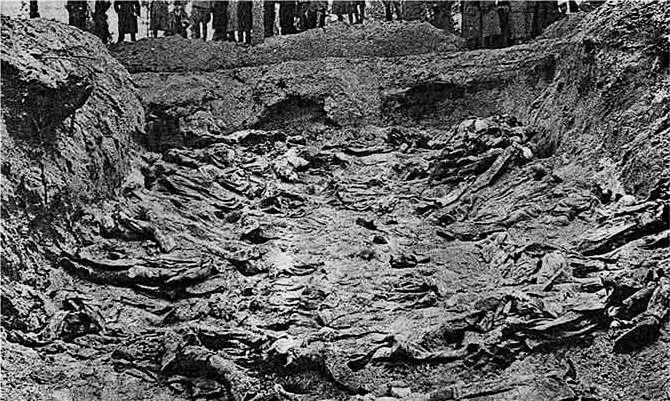   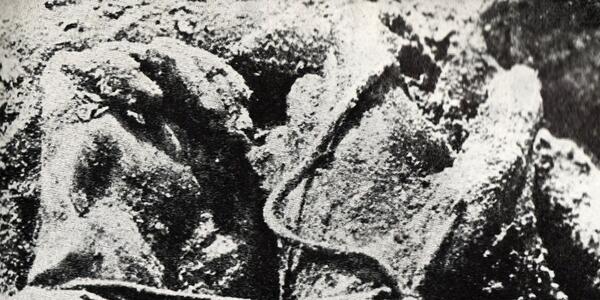 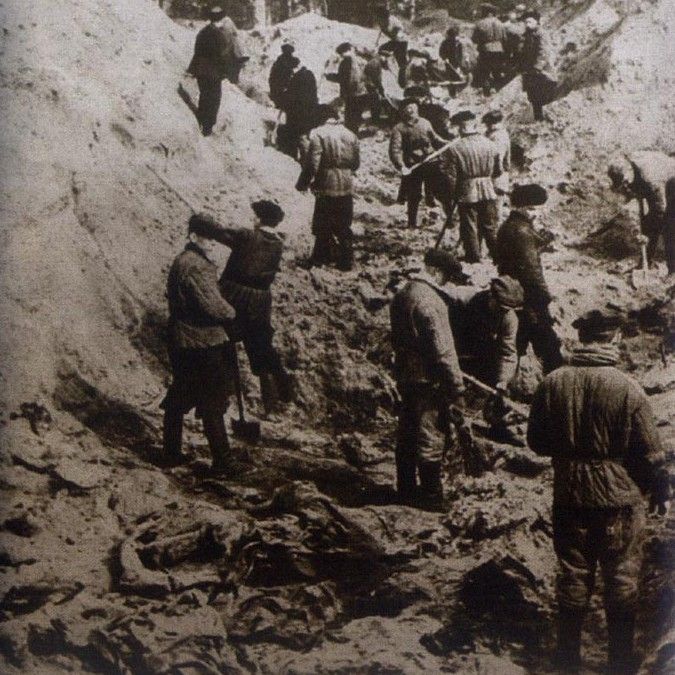   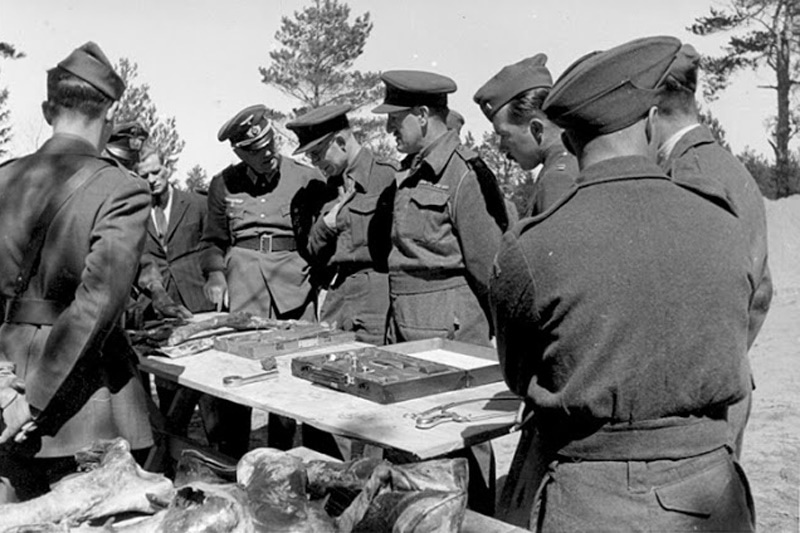  
|
|
|
|
Post by valpomike on Apr 14, 2010 16:11:36 GMT 1
It took several years for the truth to get out, that the Russians did it, and not the Germans.
Now how long will it take for the world to find out the truth on the plane crash?
Mike
|
|
|
|
Post by Bonobo on Apr 17, 2010 21:44:17 GMT 1
Katyn Cemetery Katyn war cemetery (Polish: Polski Cmentarz Wojenny w Katyniu) is a Polish military cemetery located in Katyn, a small village 22 kilometres away from Smolensk, Russia, on the road to Vitebsk. It contains the remnants of 4,412 Polish officers of the Kozelsk prisoner of war camp, who were murdered in 1940 in what is called the Katyn massacre. Except for bodies of two Polish generals exhumed by German authorities in the 1940s and then buried separately, all Polish officers murdered in Katyn were buried in six large mass graves. There is also a Russian part of the cemetery, where an undisclosed number of victims of the Soviet Great Purges of the 1930's were buried by the NKVD. The cemetery was officially opened in 2000.
The cemetery is a large, irregular area covering roughly 22 hectares of forest. All mass graves are located on both sides of the main alley. There is also a circular alley with thousands of names of the officers who perished in the massacre. At the end of the main alley there is a war memorial and an altar with a memorial bell located underground.
[edit] History
Initially, after the exhumation of 1943, the Germans had permitted the Polish Red Cross to build a cemetery on the spot. However, following the Soviet take-over of the area it was destroyed and most evidence removed. The area was again forested and civilians were banned from entering the area. As the knowledge of the massacre was suppressed in Communist countries, in 1976 the Polish Government in Exile awarded the Katyn Memorial in London with the cross of Virtuti Militari, the highest Polish military award.
Following Soviet admittance of the crime in 1990, the exhumation and archaeological works were resumed. In 1994 a bi-lateral treaty on war cemeteries and war memorials was concluded between Poland and Russia. This paved the way for a construction of a proper war cemetery in Katyn. After several years of construction it was opened to the public on July 28, 2000. That year also similar cemeteries were opened at other mass murder sites of Piatikhatki (near Kharkiv), Smolensk, and Mednoye. The Virtuti Militari awarded to the monument in London was then transferred to Katyn, which became one of the very few places in the world among its recipients.
During the opening ceremony the spot was visited by the highest Polish and Russian authorities. Among them were the Prime Ministers Jerzy Buzek and Viktor Khristenko, as well as Marshals of Sejm (Maciej Płażyński) and Senate (Alicja Grześkowiak). The ceremony was opened by the Polish Chief of General Staff Gen. Henryk Szumski and concluded with a Catholic mass celebrated by the primate of Poland Józef Glemp, while the Orthodox ceremony by Metropolitan bishop of Smolensk Cyril Gundyaev. There were also prayers of other denominations held, as there were also Protestant, Muslim and Jewish victims of the NKVD buried there.
On April 10th, 2010, the Polish President Lech Kaczynski, his wife and another 94 people including many of his top staff members, more than a dozen members of the Parliament and leaders of the military died when the presidential plane went down about a half mile from the runway in the Russian city of Smolensk. The Polish delegation was on its way to take part in a ceremony there to commemorate the Soviet massacre of more than 20,000 members of Poland’s elite officer corps 70 years ago.en.wikipedia.org/wiki/Katyn_war_cemetery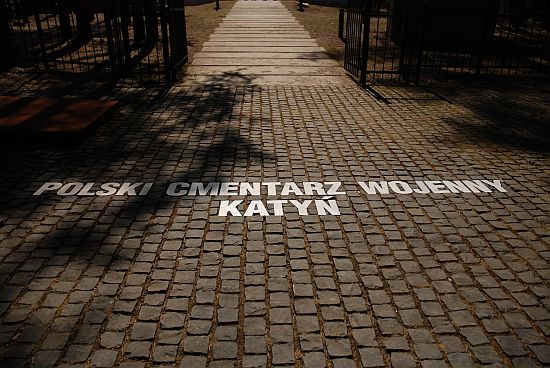     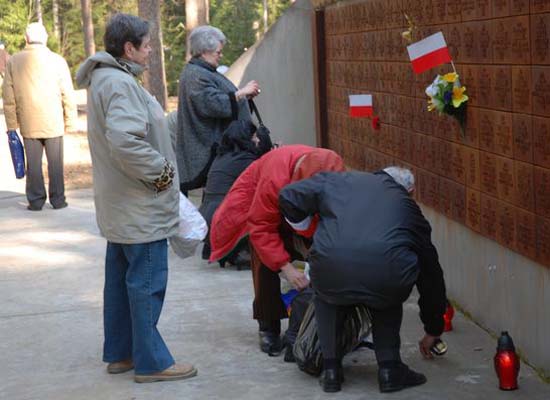  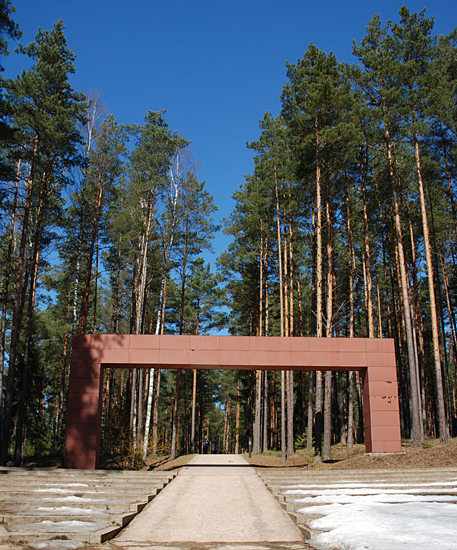  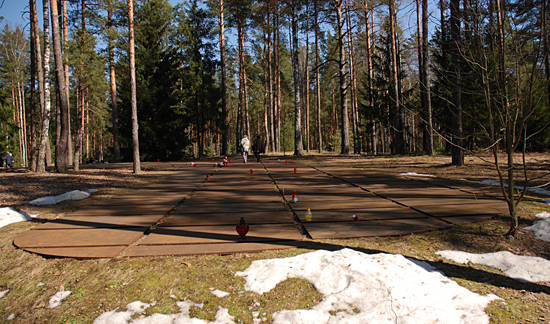 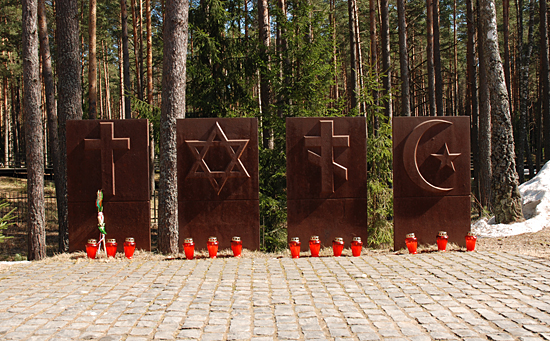  polonia.wp.pl/gid polonia.wp.pl/gid,11642376,galeria.html |
|
|
|
Post by valpomike on Apr 18, 2010 17:44:56 GMT 1
Let's us all never forget, or forgive this action.
Mike
|
|
|
|
Post by jeanne on Apr 19, 2010 17:15:06 GMT 1
Let's us all never forget, or forgive this action. Mike We must not forget, but not forgiving only leads to more of the same. |
|
|
|
Post by tufta on Apr 19, 2010 17:18:43 GMT 1
Let's us all never forget, or forgive this action. Mike We must not forget, but not forgiving only leads to more of the same. ...especially that those directly guilty are dead long ago, so there's none to forgive. Enough that we demand the whole truth from those alive. We have the growing number of Russians as allies here. |
|
|
|
Post by Bonobo on Apr 19, 2010 22:11:20 GMT 1
We must not forget, but not forgiving only leads to more of the same. ...especially that those directly guilty are dead long ago, so there's none to forgive. Enough that we demand the whole truth from those alive. We have the growing number of Russians as allies here. Yes, Tufta and jeanne. Forgiveness is a desirable virtue. I think many Poles share this opinion. |
|
|
|
Post by tufta on Apr 20, 2010 8:05:57 GMT 1
Most of all however we need the archives of the Katyn massacre be opened by Russia, the murdered victims rehabilitated. Only then the absolutely great gestures of Russian authorities related to Smolensk catastrophe will become a hallmark of a real change in mutual attitude. And with a changed attitude the naturally existing conflicts of interests will be much easier to overcome and to come to terms with. Perhaps even decrease the number of? Attitude does miracles even in politics.
|
|
|
|
Post by coco on Apr 20, 2010 13:07:16 GMT 1
Well, it have been 70 years and how can Polish people forgive. Poles could forget it but don't want to.
Poles want to keep Histories. Which is very important for people all over the world?
Here in Americ, we can't forget 9/11 and still being cautious. Look at Pearl Harbor. I could go on but I feel very sad for Poland.
|
|
|
|
Post by valpomike on Apr 20, 2010 15:43:00 GMT 1
We must never forget, and must all ways remember, what they did.
Mike
|
|
|
|
Post by Bonobo on May 9, 2010 21:43:51 GMT 1
|
|
|
|
Post by Bonobo on Sept 3, 2010 23:57:33 GMT 1
Polish tribute at Mednoje mass graves site
02.09.2010 14:02
Ceremonies are held marking the 10th anniversary of the Polish War Memorial Cemetery in Mednoje, the site of mass graves of Poles killed by the Soviets during WW II.
This is the site where mass graves of over 6,300 Polish POWs murdered by the NKVD in 1940 had been discovered.
Several hundred visitors have arrived from Poland for the anniversary of opening the War Memorial Cemetery, mostly from the Association of Katyn Families – an organization affiliating family members of the victims.
Many have come to Mednoje for the first time, like Marek Gromelinski:
“I want to pay tribute to my grandfather. My father is sick and couldn’t come, so at least the grandson is here. I want to fulfill my family obligation and visit his grave, light a candle… This is very important,” Gromelinski told Polish Radio.
Following the Soviet aggression on Poland at the start of World War Two, some of the captured uniformed Poles were transported to the camp in Ostashkov, from which they were taken to regional NKVD headquarters in erstwhile Kalinin (presently Tver) and executed on Stalin’s orders. Their bodies were buried in nearby Mednoje.
|
|
|
|
Post by Bonobo on Dec 2, 2010 19:22:00 GMT 1
A long awaited step...
Russian Parliament Recognizes Katyn Massacre as Crime by Stalinist Regime
The State Duma, lower house of Russian parliament, approved a resolution, on Friday which recognized the responsibility of the Soviet dictator Josef Stalin for the WWII massacre of 22,000 Polish army officers and civilians in Katyn forest in western Russia.
The document breaks years of official reluctance to admit that the Soviet leadership ordered the killings in 1940. The Nazis had been accused by the Soviet Union of the murders and only in 1990 Mikhail Gorbachev, the then General Secretary of the Communist Party of the Soviet Union admitted Soviet guilt, a year before the bloc disintegrated.
Poland’s Foreign Ministry welcomed the resolution of Russia’s State Duma with great satisfaction.
“The recognition of the responsibility of the Stalin regime for the execution of thousands of Polish officers in the Katyn forest by the Russian parliament is an important step towards reconciliation of the two countries”, the Polish Foreign Ministry’s statement read.
Former Polish president Lech Walesa called the State Duma’s declaration “a step in the right direction”.
Speaker of the Polish parliament Grzegorz Schetyna said that the document will create the most favorable conditions for [Russian]President [Dmitry] Medvedev's visit to Poland on December 6.
|
|
|
|
Post by Bonobo on Apr 14, 2011 18:25:04 GMT 1
High time, indeed.
President Komorowski has revealed in an interview on Poland’s public TV that his Russian counterpart, Dmitry Medvedev, will find a legal path to speed up the process of rehabilitation for the Poles murdered under Soviet rule during the 1940 Katyn crime.
The process, normally applied to those unjustly sentenced in court, would clear the executed men of any stain on their honour under Russian law.
There have been some apparent complications over the matter as technically, the 22,500 Poles, largely reserve officers, were executed without trial.
Members of the Association of Katyn Families have long petitioned for rehabilitation, as has Russian human rights group Memorial.
“All the Poles shot here should be rehabilitated under the Russian law on rehabilitation,” declared Arseny Roginsky, founder and chairman of the International board of Memorial, in the wake of the Smolensk air crash last year, a disaster that prompted much soul-searching in Russia.
“And it is untrue that rehabilitation is difficult because the Polish prisoners were shot without trial,” he argues, citing the example of Swedish diplomat Raoul Wallenburg, who died in Russian detention in 1947, and was fully rehabilitated in 2000.
“The Russian side has nothing to fear in this,” Roginsky postulates. “The law is such that it does not provide compensation, only a moral 'compensation' in the sense of a posthumous recognition of those who died as innocent victims.”
Moscow officially admitted guilt for the crime in 1990. However, until recently, it was still commonplace to find articles in Russian newspapers rehashing the wartime propaganda that it was the Germans that had conducted the crime. Likewise many of the victims were described as spies, with little prominence given to the varied professions of the murdered, amongst whom were artists, professors and doctors.
Roginsky believes that the matter could be cleared up, once all names of the executed are formally declared:
“The rehabilitation of the executed Poles could simply be done by means of a decree issued by the president of Russia. To do this, he would merely need a complete list of victims.”
|
|
|
|
Post by Bonobo on Apr 23, 2011 10:42:59 GMT 1
An accident of history
The Smolensk plane crash wiped out much of Poland's political and military elite and brought the Soviet massacre at Katyn back into focus. Can this new tragedy heal old wounds?
Neal Ascherson
Bodies of Polish officers are exhumed at Katyn, 1943
The bodies of Polish officers being exhumed from a mass grave in Katyn, 1 April 1943. Photograph: AFP/Getty Images
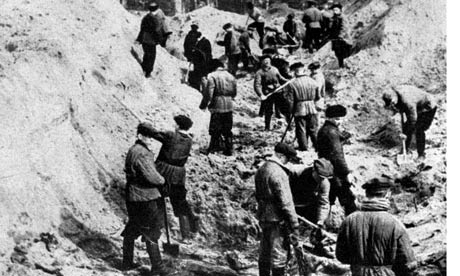
A human being cannot be beheaded twice. But a nation can. Twice in less than a century, Poland's elite – political, military, ministerial – came to a terrible death in the woods around Smolensk. Ordinary Poles with history in their bones can't be blamed for fearing, last weekend, that the beheading axe was swung by the same hands.
But it was an accident. The fact that President Lech Kaczynski and his retinue had flown to commemorate the 70th anniversary of the Katyn massacre, only a few miles away, was one of those malign coincidences that haunt Polish history. And it happened at a moment when Russia and Poland were trying, with some success, to put their long and dreadful past behind them. The spontaneous, great-hearted grief of ordinary Russian people in the days after the air crash amazed and then moved the Poles.
Maybe the old icons of hate and suspicion were losing their power at last. Even Katyn.
To understand why Katyn has been the unhealed wound between Poland and Russia, two stories need telling. One is what really happened in 1940 in that forest – and what it was part of. The other is the 60-year cover-up, the big Soviet and Russian lie which the British and American governments at first endorsed. Grief for the dead lasts all of a life. But thirst for the truth, the pain of being lied to, burns on for generations.
Since the middle ages, when the mighty Polish commonwealth tried to dominate the infant Russian state, Russia had regarded Poland not as a rival but as a deadly enemy. Then Poland grew weaker, between the two aggressive military tyrannies of Prussia and Russia. At the end of the 18th century, Poland was invaded and partitioned. In Russian Poland, in spite of desperate and unsuccessful rebellions, the Polish language, the Catholic religion and the very notion of Polish identity were persecuted. In 1918, Poland regained its independence, only to be briefly invaded by Bolshevik Russia in 1920. Stalin and Hitler looked on the revival of Poland as a criminal "abortion", and the secret clauses of the Nazi-Soviet pact in 1939 agreed on a new partition to wipe Poland off the map for ever.
Hitler invaded Poland on 1 September 1939. On 17 September, without warning, the Soviet armies entered Poland from the east, taking the retreating Polish forces by surprise. Last year, the late President Kaczynski called this, accurately, "a stab in the back". Thousands were taken prisoner, and eastern Poland was annexed into the Soviet Union.
Now comes a blank, a missing piece in the story. We do not know whether the Nazis and the Soviets agreed in detail on how to crush the Poles. But officers from the NKVD (predecessor of the KGB) and the Gestapo had regular meetings at Zakopane in Poland, between late 1939 and early 1940. Soon, the Germans were to launch their own "beheading" programme in their part of Poland, starting with the execution of the academic staff of Kraków University and going on to target the priesthood and intellectuals.
Stalin had a double problem. In the annexed territories, the men of active age were now almost all either prisoners of war or had escaped into Romania or Hungary. That left a large civilian population composed mostly of women, children and the old. It was decided to deport the Polish civilians en masse, leaving the region to its Ukrainian and Belorussian inhabitants. The Polish families were herded into cattle trucks and sent to the labour camps of the Arctic or the barren steppes of Kazakhstan where, it was assumed, they would either die out or mature into loyal Soviet citizens. The figures aren't certain, but the deportees seem to have numbered around 1.25 million. Two years later, only about 800,000 were still alive.
This left the question of the 14,700 prisoners of war, and of the 11,000 Poles held in prisons because they were judges, intellectuals, landowners or police officers. Stalin and Lavrentiy Beria, head of the NKVD, were quite right to see that their very existence ensured that somewhere, some day, a free and anti-Soviet Poland would resurrect itself. Stalin decided to kill them all, immediately.
Astonishingly, the order itself has survived. It is a four-page document, signed in pencil by Stalin, with the signatures of Voroshilov, Molotov, Mikoyan, Kalinin and Kaganovich underneath.
It reads in part: "In the NKVD camps for war prisoners and in prisons … is currently detained a large number of ex-officers of the Polish army, ex-members of the Polish police and intelligence services, members of Polish nationalist and counter-revolutionary parties, members of organisations exposed as counter-revolutionary and insurrectionist, fugitives and others. All are persistent enemies of Soviet power, and full of hatred for the Soviet outlook … To be treated in the special mode with the application in their case of the ultimate measure of punishment – shooting."
The order is dated 5 March 1940. In April, the executioners began their work, and Beria went on to kill many thousands of other Poles in other parts of the Soviet Union. The main killings were done in three different locations. The prisoners of war from the Kozielsk camp were killed at Smolensk or in Katyn forest and buried there. Those from Ostashkino were shot at Tver (buried at Mednoye); those from Starobielsk in Kharkov (buried at Piatykhatky). Decades later, this mass grave was found by children playing with dozens of Polish army buttons.
The NKVD killers handcuffed their victims or tied their hands behind their backs with wire, then shot them in the back of the head. At Katyn, the dying Poles fell into a huge trench dug by bulldozers in the forest. In Tver, they were pushed one by one into a soundproof room and shot, their bodies shoved through a hatch into the back of a truck outside. The NKVD men found it hard work because of the sheer numbers. The department's champion executioner, Vassily Mikhailovich Blokhin, said he killed 6,000 men in 28 days.
Was it genocide? Of course. It was not the extermination of an entire ethnic group, on the scale of the Jewish Holocaust or Rwanda. But it was the selective, deliberate murder of a nation's elite, with the intention of castrating its political and creative energy for the future.
Measured in numbers, other horrors of the time outscale Katyn. In German-occupied Poland, some 5.4 million people died in camps or mass executions, 3 million of them Jews. Nazi policy towards the main Polish population at first resembled the "beheading" tactic favoured by Stalin, but later widened into indiscriminate slaughter. Again, the Polish death toll caused by the NKVD's civilian deportations in 1940-41 was perhaps 10 times that of Katyn. And yet the crime of Katyn retains a special foulness all its own. It was a true atrocity, in every shade of the word's meaning.
Why is this so? In the first place, because of its black treachery, beginning with the secret clauses of the Nazi-Soviet pact and ending in the betrayal of helpless men who assumed they had the protection granted to prisoners of war. But the second reason for Katyn's lasting infamy, for the way its pain refuses to be anaesthetised by time, is the lie under which it was buried.
The lying began almost at once. When Hitler attacked the Soviet Union in 1941, the Poles imprisoned and enslaved there were "amnestied" (as if they had committed a crime) and allowed to form the nucleus of an army. Soon it became clear that thousands of prisoners of war, mostly officers, were missing. Stalin affected surprise when General Sikorski, the Polish exile leader, told him so. "That's impossible. They have fled … To Manchuria, for instance."
In July 1941, the advancing Germans reached Smolensk. It was not until 1943 that a Russian peasant led them to the nearby Katyn woods, where they found mass graves containing the bodies of more than 4,000 Polish officers. Their uniform pockets still contained letters and papers whose final dates were in April 1940. Joseph Goebbels, Hitler's propaganda minister, grabbed his opportunity. The continent's media and an "international forensic commission" were summoned to witness the exhumations. Nazi propaganda trumpeted the evidence of a "bestial Bolshevik crime".
The impact was devastating and, as Goebbels had intended, shook the whole anti-Hitler alliance. Sikorski's government in London demanded an International Red Cross inquiry. Moscow retorted furiously that Katyn was a German atrocity, and in July broke off relations with the Polish government. The Allied reaction was mixed. The British public, admiring the Russians as "our gallant ally", were inclined to believe them. The British government, including Churchill, privately assumed that the USSR was guilty, but moved harshly to suppress anybody who said so in public. When the eccentric poet Count Potocki de Montalk sold his own Katyn Manifesto around London, he was immediately arrested and imprisoned. In the US, where President Roosevelt genuinely believed Katyn was a German crime, reports demonstrating Soviet guilt were being suppressed as late as 1945.
The Poles, however, knew the truth and made themselves unpopular by trying to tell it. Even Polish Communists were secretly disgusted by the 1944 Soviet "Burdenko commission", which used planted evidence and dummy witnesses to "prove" Nazi responsibility. In 1948, Soviet prosecutors shamelessly added Katyn to the indictment against Nazi leaders at the Nuremberg tribunal.
The leaders of the postwar Polish Communist regime, like all their unwilling subjects, knew perfectly well what had happened. But they criminalised all mention of Katyn except as a Nazi war crime. This did not stop Polish people from erecting "Katyn crosses" in the cemeteries on All Souls' Day, or prevent teachers whispering to their pupils that they shouldn't believe the official version of who had murdered the flower of Poland's officers. Probably apocryphal is the story that Warsaw tram-conductors used to sing out "Katyn forest!" as the tram stopped by the Palace of Culture, Stalin's monstrous "gift to the Polish people". But awareness of this great lie remained the regime's achilles heel. I never met a Communist official in Poland whose eyes did not flinch when I mentioned Katyn.
During the cold war, the west changed its mind and enthusiastically added Katyn to its stock of anti-communist ammunition. But even as the cold war came to an end, Mikhail Gorbachev was remarkably reluctant to come clean, admitting Soviet responsibility but implying Beria had acted on his own, without state authority. It was his successor Boris Yeltsin, knowing Gorbachev had taken secret files with him when he left the Kremlin, who forced him to surrender the key document: Stalin's unambiguous order to shoot the Poles.In 1992 Yeltsin went to Warsaw and handed the document to President Lech Walesa. He knelt to kiss the wreath at the Katyn memorial, and then promised to pay reparations and punish the surviving murderers. Neither promise has been kept.
But Russian-Polish relations have warmed in the past couple of years. Vladimir Putin has said he wants freedom "from the ghosts of the past". The Smolensk air crash, like a terrible human sacrifice to end an ancient clan feud, has released a passion for reconciliation between the two peoples.
Will it last? The sources of suspicion remain: Russia's scheming with Germany "behind Poland's back", Poland's interest in drawing Ukraine westwards, Russian paranoia about Poland's role in Nato and its taste for American missiles. Russian nationalists, who don't do apologies, will go on denying Katyn. Yet the Polish and Russian governments now have a chance to exploit the new mood, confess to those suspicions and launch a programme to defuse them. Then the second blood sacrifice at Katyn will not have been in vain.www.guardian.co.uk/world/2010/apr/17/smolensk-crash-katyn-accident-of-history?INTCMP=ILCNETTXT3487 |
|
|
|
Post by Bonobo on May 6, 2011 23:40:10 GMT 1
First finds in Katyn exhumation
05.05.2011 14:16
Archaeologists working at a former Soviet killing field in Bykivnia, Ukraine, have found new evidence testifying to the murder of Polish citizens there during World War II.
A so-called police chip containing the identification number of a Warsaw district police officer has been revealed today, bolstering Polish convictions that 3500 victims from the Katyn Crime are buried at the site.
In 2007, Polish archaeologists working at Bykivnia discovered the dog tags of Sergeant Jozef Naglik, as well as a comb with the names of four Poles inscribed on it.
The names tallied with the so-called Ukrainian List, which makes up about 15 percent of the 22,500 Poles murdered by Soviet Secret Police (NKVD) during the Katyn Crime.
Poland plans to open a necropolis on the site, with a tentative opening date of April 2012.
The current excavations, led by the Council for the Protection of Struggle and Martyrdom Sites (ROPWiM) mark the final stage in the process before construction of a cemetery begins.
Soviet victims from several nations are understood to be buried at the site, with some estimates as high as 150,000.
Polish experts began investigating the site in 2001, with the blessing of authorities in Kiev.
|
|
|
|
Post by Bonobo on Feb 17, 2012 23:54:00 GMT 1
Polish conservation council against 1940 Katyn massacre exhumations
17.02.2012 10:29
A Polish governmental conservation council is against the exhumation and repatriation of Polish victims of the 1940 Katyn massacre, when over 20,000 Polish officers were murdered on Stalin's orders.
"Bringing the remains of the victims of the Katyn Crime back to our country is impossible," Dr Andrzej Kunert, Secretary of the Council for the Protection of Struggle and Martyrdom Sites told the Rzeczpospolita daily.
A group of 80 relatives of Katyn victims had earlier appealed to Poland's Foreign Ministry, calling for the remains of those murdered to be brought back from Russia so as to be buried on Polish soil.
The Foreign Ministry directed the request to the Council for the Protection of Struggle and Martyrdom Sites.
However, Poland's Federation of Katyn Families had objected to the proposals from the outset.
“Why do we need such actions?” said Krystyna Brydowska, deputy chairman of the Federation Katyn Families, in an interview with Rzeczpospolita last month.
“After all, we already have cemeteries,” she said.
Over 22,500 Polish citizens, largely reserve officers, were executed on Stalin's orders in April 1940.
The shootings took place at various points across the Soviet Union.
Official cemeteries exist at Katyn and Mednoye (both in Russia), and the foundation stone for a third was laid at Bykivnia, Ukraine, last November.
The Polish military cemetery at Katyn, near Smolensk, was launched in 2000, ten years after Moscow finally admitted guilt for the murders. Until then, the official Moscow line had been that the Nazis were responsible for the executions.
Dr Kunert stressed that one of the paramount problems was in identifying each victim.The majority of the victims have symbolic graves.
However, some relatives of the murdered have more precise information, owing to the presence of personal effects.
Nevertheless, Dr Kunert has added that no stipulation about further exhumations was ever agreed with Russia when the cemeteries were launched
|
|
|
|
Post by Bonobo on Apr 6, 2012 10:57:20 GMT 1
Poland and Russia in 1940 Katyn massacre talks
04.04.2012 13:29
Talks were renewed in Moscow on Wednesday concerning the legal rehabilitation of around 22,000 Polish officers executed on Stalin’s orders in 1940.
Lukasz Kaminski, head of Poland's state-sponsored Institute of National Remembrance (IPN) – which investigates crimes against Polish citizens – is holding talks with Mikhail Fedotov, head of Russia's Presidential Council on Human Rights.
Fedotov, a former journalist, is an advocate of amending Russian law so that the 22,500 Poles can be legally ‘rehabilitated’ and is preparing recommendations on the matter for President Vladomir Putin.
The victims of the 1940 crime were murdered at various locations across the Soviet Union, including the Katyn Forest near Smolensk, western Russia.
Although Moscow officially admitted guilt for the crime in 1990 – after claiming for decades that the German Nazis were to blame - the process of rehabilitation is normally applied to those unjustly sentenced in court, which provides a stumbling block as there was no court sentence for the Poles, a large portion of whom were reserve army officers.
The process would clear the victims of any stain on their honour under Russian law.
It has been anticipated that the meeting with Fedotov will also touch upon prospective cooperation between Poland and Russia regarding other Soviet crimes.
Kaminski is also set to meet other human rights representatives, including members of the prominent Memorial Society, which was founded in 1987.
The talks come less than two weeks before the European Court of Human Rights pronounces its verdict in a case relating to the WWII Katyn Massacre.
The case was brought by a number of families of the victims, who accuse Russian authorities of not conducting an effective investigation after the inquiry was broken off in 2004, unacceptable treatment of the bereaved families and a failure to cooperate with the European Court of Human Rights itself.
|
|
|
|
Post by Bonobo on Feb 23, 2013 22:55:18 GMT 1
Katyn case returns to European Court of Human Rights
13.02.2013 13:08
A hearing was held at the European Court of Human Rights on Wednesday morning, with 15 Poles bringing complaints against Russia over the WWII Katyn Massacre.
The case, which has been referred to the court's 17-member Grand Chamber following an April 2011 judgement by a chamber of seven judges, is expected to close with a final judgement by the end of the year.
Among several issues at stake, the Polish applicants are seeking to establish that Russia did not carry out an adequate investigation into the 1940 shootings of over 22,000 Polish prisoners of war.
The 15 Poles are relatives of 12 victims of the killings.
“We are optimistic,” said Ireneusz Kaminski, a member of the Poles' defence team, as cited by the Polish Press Agency (PAP). “We have prepared a very strong argument making wide-ranging references to international law and the decisions of international courts,” he said. “We hope that there will be no surprises on the part of the Russians,” he added.
Moscow officially admitted guilt for the killings with the fall of the Iron Curtain, but its official investigation between 1990 and 2004 was broken off.
In last April's judgement, the Strasbourg court concluded that the killings constituted “a war crime,” and that several of the applicants had suffered “inhumane treatment” by Russian authorities.
However, the seven-member chamber was split over whether the court was able to rule on the adequacy of Russia's investigation, because the European Convention on Human Rights only came into force in Russia in 1998, eight years after Russia's Katyn investigation began.
The Chamber ultimately concluded that it was not able to rule on the matter, although the Polish legal team is hoping that the Grand Chamber will be of a different opinion.
Following today's public hearing, the judges deliberations will be carried out behind closed doors.
Other issues that will be resolved include the question of compensation.
When the case was initially filed in 2007, the Poles stated that they would forego compensation, save for a symbolic euro.
However, when more families joined the case, various claims for more substantial compensation were made.
Meanwhile, the Poles were displeased with the April ruling that only 10 of the 15 had suffered inhumane treatment at the hands of Russian authorities in their long-running bids to find out what had happened to their relatives.
The court ruled that “inhumane treatment” was not applicable to the remaining five, as they had no personal recollections of the deceased, even though once again, some were children of the murdered prisoners of war.
The complainants are being backed by Polish government, as well as several NGOs, including Russian human rights group Memorial and Amnesty International. An execution scene from the film Katyñ at 1:48:00: www.radiodienst.pl/tag/polen-katyn-verbrechen/?print=print-search 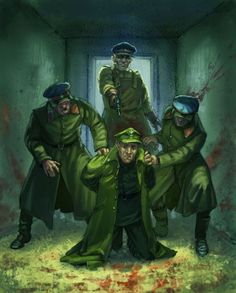 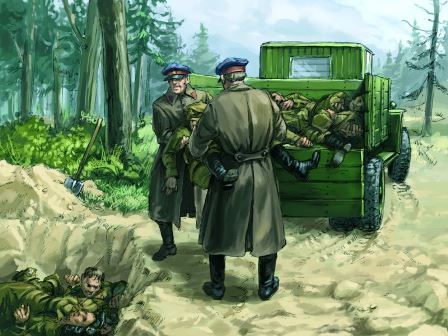 
|
|
|
|
Post by Bonobo on Apr 9, 2017 16:54:07 GMT 1
Polish foreign ministry 'disappointed' with Katyn sign 08.04.2017 12:00 The Polish foreign ministry has issued a statement expressing “deep concern and disappointment” over a sign which appeared outside the Smolensk memorial in western Russia. The sign installed at the Katyn cemetery. Photo: smoldaily.ruThe sign installed at the Katyn cemetery. Photo: smoldaily.ru  The controversial sign appeared next to Polish graves in Russia, suggesting that Red Army soldiers held captive by Poles during the Polish-Soviet War (1919-1921) suffered inhumane conditions and tens of thousands never returned home. The Polish foreign ministry said the signs featured “false information” about the Bolshevik prisoners of the war who had died in Polish captivity. The sign is located a few dozen metres away from the mass graves of some 4,500 Polish victims of the Katyn massacre of 1940. According to the sign, some 175,000 Red Army soldiers were taken captive in the Polish-Soviet War, but 75,000 did not return home. The ministry said that the information on the signs at the cemetery, “notably the figures of deceased POWs, exceed by a few [multiples] the actual numbers that have been confirmed by Polish and Russian historians”. The statement added that “the majority of the prisoners died because of camp conditions that resulted from the dramatic economic situation of Polish lands after a long-time struggle for independence. Those conditions equally affected the Russian soldiers and Polish citizens.” The signs were installed by the Russian Military-Historic Association which is headed by Russian Culture Minister Vladimir Medinsky. Medinsky has in past referred to POW camps used by Poles in the Polish-Soviet War (1919-1921) as “concentration camps”. The statement by the ministry said that Poland has “repeatedly heard assurances from senior [Russian] officials of the willingness for dialogue and cooperation to constructively solve issues that divide our countries.” “Poland is ready for an open and constructive debate in order to avoid disputes about history between our countries and to solve the existing ones,” the statement said. |
|
|
|
Post by jarmo on Jan 27, 2018 19:32:59 GMT 1
Hello!
I joined this site after seeing discussion about Katyn murders by NKVD in 1940. I am a Finn and interested in history. There has been speculation that Stalin intended to use the same method of dealing with perceived counterrevolutionaries in Finland, had the Russians been able to conquer Finland in Winter War. I think that there were rumours in the camps about this in the spring of 1940.
I am especially interested in the Ostashkov camp, or more precisely, Stolobny Island camp in Lake Seliger. The Polish prisoners there were mainly police officers . It seems the events here were closer to NKVD standard practice than at Kozelsk and Katyn.
And the executioner was Stalin's #1 man, Vasily Blokhin, who also executed Soviet generals, NKVD heads and Old Bolsheviks.
|
|
|
|
Post by Bonobo on Jan 28, 2018 3:50:11 GMT 1
Hello, There has been speculation that Stalin intended to use the same method of dealing with perceived counterrevolutionaries in Finland, had the Russians been able to conquer Finland in Winter War. I think that there were rumours in the camps about this in the spring of 1940. I am especially interested in the Ostashkov camp, or more precisely, Stolobny Island camp in Lake Seliger. The Polish prisoners there were mainly police officers . It seems the events here were closer to NKVD standard practice than at Kozelsk and Katyn. Hello, welcome to the forum. 1 It is obvious Soviets would introduce the same bolshevik terror in Finland after conquering it. The Finns knew it very well, that`s why they defended their country with such clever persistence though grossly outnumbered by the Red Army. It is enough to read about the territory that the Soviet Union grabbed from Finland. www.genealogia.fi/emi/art/article226e.htm
Even though the Finns were a very small group, they were the target of a most intense terror campaign in Soviet Karelia and their human losses were perhaps among the heaviest in the whole of the country when seen in relation to the population figures of a given area. The explanations are found in the widely disputed large-scale aims of the Stalinist regime, and in our case in the nature of the Finnish nationality group itself as well as in the problem of Finnish-Soviet relations. Finland had gained its independence from the Russian empire in 1917. Tension prevailed for a long period between Finland and the Soviet Union, and was also increased by the Civil War in Finland between the Reds and Whites in 1918, in which the Whites were victorious. It resulted also in the banning of the communist movement in Finland - while there were underground connections from the Soviet side to Finland. The inter-war period was characterised by tensions between Finland and the Soviet Union.books.google.pl/books?id=0RuDCgAAQBAJ&pg=PA273&lpg=PA273&dq=finland+stalin+terror&source=bl&ots=7n9TBCii_x&sig=Oq2f7djQ7yrU_LseGcjcqEYYIaU&hl=pl&sa=X&ved=0ahUKEwjm4L2q0fnYAhUGlCwKHVBhDzUQ6AEIRjAH#v=onepage&q=finland%20stalin%20terror&f=falseThe few Finnish Communists to survive Stalin's terror were those locked up in Finnish prisons. According to later estimates, 20,000 Finns died in Stalinist labour camps in the infamous Gulag Archipelago. Pan-Finnish propaganda played into the hands of Moscow, allowing it to accuse Finland of wanting to annex EasternWhy such interest in Stolobny Island? |
|
|
|
Post by jarmo on Jan 28, 2018 8:48:20 GMT 1
I have thought writing about it and would therefore like to learn more.
The Finns in the USSR were persecuted vigorously in late 1930s, as were the Poles. I think 100 000 people of Polish descent were executed. Also the NKVD was purged of minority nationalities and Jews. Georgians were a notable exception.
Back to Ostashkov: I have read about the testimony of Dimitri Tokarev which has been widely quoted in various sources. However, I have not heard of forensic evidence although there must have been exhumations carried out in the 1990s. The burial site is now a memorial, I understand.
I read that in other camps the PoWs were vaccinated to give them false sense of security prior to executions. Did this also happen in Ostashkov camp?
|
|
|
|
Post by Bonobo on Jan 28, 2018 9:48:50 GMT 1
I am especially interested in the Ostashkov camp, or more precisely, Stolobny Island camp in Lake Seliger. The Polish prisoners there were mainly police officers . It seems the events here were closer to NKVD standard practice than at Kozelsk and Katyn. Mainly but not only. Among 6364 POWs in Ostashkov camp in March 1940, there were 48 Polish army officers 240 police and military police officers 774 police and military police non-commissioned officers 4924 low ranking members of police and military police 9 intelligence members 189 prison staff members 5 priests 5 members of judiciary 6314 were executed and buried in Miednoje. www.ogrodywspomnien.pl/index/historia,4,Miednoje Average age of the executed: 41. 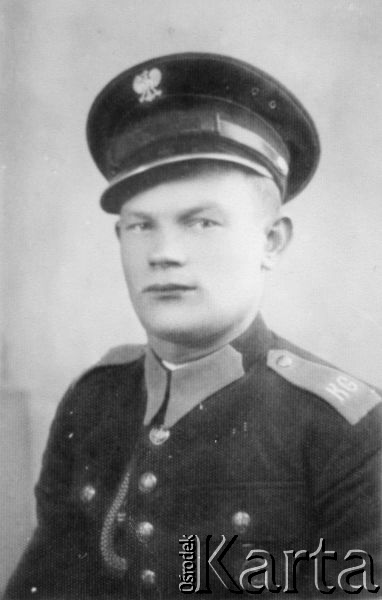    |
|
|
|
Post by Bonobo on Jan 28, 2018 10:20:59 GMT 1
|
|
|
|
Post by Bonobo on Jan 28, 2018 10:50:27 GMT 1
|
|
|
|
Post by jarmo on Jan 28, 2018 15:30:52 GMT 1
Thank you, very useful material.
I used Google translator which makes documents quite readable. This one sentence remains unclear:
Symbole uwidocznione na łuskach to litery "DWM"
i dwie litery "K" po bokach, identyfik~jące jako producenta niemiecką
firmę "Deutsche Waffen und Munitionsfabriken AG,
Karlsruhe".
Are they talking about bullets or shell cases? Translator gave me "scales"
|
|
|
|
Post by Bonobo on Jan 28, 2018 17:26:57 GMT 1
Thank you, very useful material. I used Google translator which makes documents quite readable. This one sentence remains unclear: Symbole uwidocznione na łuskach to litery "DWM" i dwie litery "K" po bokach, identyfik~jące jako producenta niemiecką firmę "Deutsche Waffen und Munitionsfabriken AG, Karlsruhe". Are they talking about bullets or shell cases? Translator gave me "scales" The letters visible on shells are DWM, and two letters K on both sides, which allow to identify the producer as a German company ...... They must mean letters placed at the bottom of shells, e.g.,  The translator gave you scales because łuski means both gun shells and scales in fish. |
|
|
|
Post by Bonobo on Jan 28, 2018 18:06:38 GMT 1
I read that in other camps the PoWs were vaccinated to give them false sense of security prior to executions. Did this also happen in Ostashkov camp? I found nothing about it, they were vaccinated but upon arrival to the camp. |
|